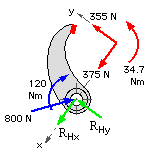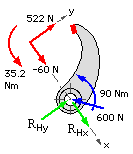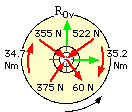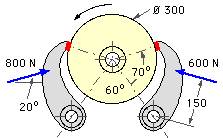individual shoe parameters
= 462
= 470




EXAMPLE
A brake consists of two identical short shoes arranged and actuated as shown. The distance between drum and hinge centres is 240 mm.
Assuming a friction coefficient of 0.5, determine :
| common shoe geometry - refer to short shoe sketch ( a) above | |||||||
| r = 150 mm ; a = 240 mm ; e = 150 mm ; θm = 70o ; so from ( 6a) | |||||||
| m = 1/0.5 x 240/150 x cos 70o = 3.007 ; and n = 1 - 240/150 x sin 70o = 0.4528 | |||||||
| The "significant figures" quoted here for checking purposes are anything but - the friction coefficient accuracy is two sigfigs at the very most ! | |||||||
| individual shoe parameters | |||||||
| LEFT SHOE | RIGHT SHOE | ||||||
| Shoes are external so Δ = +1 | leading so δ = -1 | trailing so δ = +1 | |||||
| P | (N) | 800 | 600 | ||||
| M | = | Pe | (Nm) | 0.15x800 = 120 | 0.15x600 = 90 | ||
| (6a) | N | = | M/μr( m - δΔn) | (N) | 120/0.5x0.15( 3.007+0.453) = 462 | 90/0.5x0.15( 3.007-0.453) = 470 | |
| (vii) | η | = | 1/( m - δΔn) | 1/( 3.007+0.453) = 0.289 | 1/( 3.007-0.453) = 0.392 | ||
| (viii) | S | = | mη | 3.007x0.289 = 0.869 | 3.007x0.392 = 1.177 | ||
| (5a) | Fx | = | N( Δ cosθm - δμ sinθm ) | (N) | 462(0.342+0.5x0.940)=375 | 470(0.342-0.5x0.940)= -60 | |
| (5a) | Fy | = | N( δμ cosθm+ Δ sinθm ) | (N) | 462(-0.5x0.342+0.940)=355 | 470(0.5x0.342+0.940)=522 | |
| (5a) | T | = | μNr or = ηM | (Nm) | 0.5x462x0.15 = 34.7 | 0.5x470x0.15 = 35.2 | |
| So for the brake as a whole, To = TL + TR = 34.7 + 35.2 = 69.9 Nm | |||||||
| Shoe free bodies with actuation, drum contact and hinge reaction components | 
| 
| |||||
| RHx | from Σ Fx = 0 | (N) | 800 cos40o -375 = 238 | 600 cos40o +60 = 520 | |||
| RHy | from Σ Fy = 0 | (N) | 800 sin40o -355 = 159 | 600 sin40o -522 =-136 | |||
| RH | by Pythagoras | (N) | 286 | 537 | |||
| Drum free body with reactions to above shoe-drum contacts at drum centre, and horizontal & vertical components of drum shaft support | 
| ||||||
| ROh | from Σ Fhoriz = 0 | (N) | (522-355) cos30o - (60+375) sin30o = -73 | ||||
| ROv | from Σ Fvert = 0 | (N) | (522+355) cos60o + (60-375) sin60o = 166 | ||||
| RO | by Pythagoras | (N) | 181 | ||||
The left shoe is counter-actuating hence requires a larger actuation than the self-actuating right shoe for approximately the same braking torque.
If the left shoe's LH coordinate system causes difficulty in comprehension, then the brake should be viewed from the rear - the left shoe in the front view becomes the right in the rear view.
We shall consider later the practical means for applying different actuation forces to the two shoes from a single control signal (eg. a car driver's stamping on the brake pedal).
The brake illustrates how the two opposed linings tend to balance one another so that the net load on drum shaft and bearings is small.